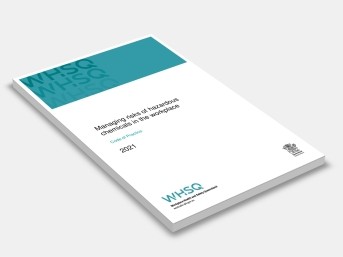Managing risks of hazardous chemicals in the workplace
Workplace Health and Safety Queensland
This code is intended to be read by a person conducting a business or undertaking (PCBU). It provides practical guidance to PCBUs on how to manage health and safety risks associated with hazardous chemicals used in their workplace.
A PCBU can be a manufacturer, importer or supplier of hazardous chemicals, or a business owner who uses, handles, generates or stores hazardous chemicals at their workplace. They may also be more than one of these things.
This code may be a useful reference for other persons interested in the duties under the WHS Act and the WHS Regulation.
This code applies to all types of work and all workplaces covered by the WHS Act.
This code applies to:
• substances, mixtures and articles used, handled, generated or stored at the workplace which are defined as hazardous chemicals under the WHS Regulation
• the generation of hazardous chemicals from work processes, for example toxic fumes released during welding.
This code does not apply to the transportation of dangerous goods or explosives which are subject to state and territory laws based on the requirements under the Australian Code for the Transport of Dangerous Goods by Road and Rail (ADG Code) and the Australian Code for the Transport of Explosives by Road and Rail 3rd edition. Most substances and mixtures that are dangerous goods under the ADG Code are also hazardous chemicals. Any person conducting a business or undertaking (PCBU) has a responsibility under WHS laws to manage the risks from hazardous chemicals, including those that are also dangerous goods.
Manufacturers, importers or suppliers of hazardous chemicals that are used, or are likely to be used, in workplaces should refer to the following codes of practice:
• Preparation of safety data sheets (SDS) for hazardous chemicals
• Labelling of workplace hazardous chemicals.
A PCBU who uses, handles or stores hazardous chemicals listed in Schedule 14 of the WHS Regulation should also refer to the Safe Work Australia Guidance materials for health monitoring.
A PCBU who operates a licensed major hazard facility or uses, handles or stores hazardous chemicals at or above 10 per cent of the prescribed threshold quantities in Schedule 15 of the WHS Regulation should also refer to the Safe Work Australia Guidance materials for major hazard facilities.
Guidance for work involving asbestos or asbestos-containing materials is available in the following codes of practice:
• How to manage and control asbestos in the workplace Code of Practice
• How to safely remove asbestos Code of Practice.
Contents:
1: Introduction
2: Identifying Hazards
3: The Risk Management Process
4: Controlling Risks
5: Monitoring And Review
6: Emergency Preparedness
Appendix A: Glossary
Appendix B: Comparison Of Hazard Classes And Categories Under The ADG Code And The GHS
Appendix C: Prohibited Carcinogens, Restricted Carcinogens And Restricted Hazardous Chemicals
Appendix D: Placard And Manifest Quantities
Appendix E: Requirements For Health Monitoring
Appendix F: Overview Of A Risk Assessment Process
Appendix G: Risk Assessment Checklist
Appendix H: Examples Of Common Fuel And Oxygen Sources
Appendix I: Fire And Explosion Risks
Appendix J: Practical Examples Of Control Measures
Appendix K: Case Studies
